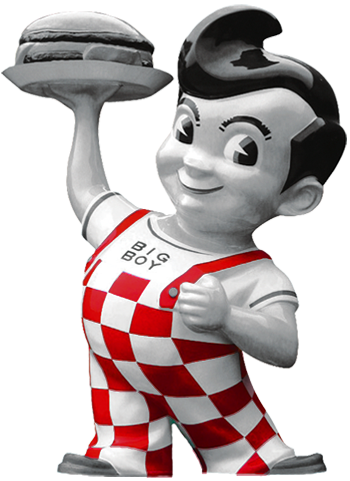Architecture
Bob's Big Boy® in Burbank is a magnificent example of the emerging California coffee shop style that exploded in Los Angeles in the 1950's.

It was designed by renowned architect Wayne McAllister, a leader in Googie architecture that embraced the automobile. Built in 1949, the structure is dramatically related to World Fair pavillions of the pre-war period by its long, low, horizontal roof line and wide canopies.
Its asymmetrical shape alternates from sharp angles at the entrance to smooth, inward curving picture windows facing the street.
Certainly the building's most striking aspect is the momumental freestanding Bob's® sign which soars vertically in contrast with the horizontal lines of the restaurant. Placed at a strategic angle, the sign, with its attractive pink and white neon lettering, is breathtakingly dramatic and visible from far down Riverside Drive. The sign itself is transitional in that it is free standing and retains elements of the 1930's streamlining. The sign is a billboard raised to an art form. At 70 feet tall, the Bob's® sign is a true landmark in the surrounding community. At night, with its dramatically lit sign and the wide band of windows highlighting the diners inside, the entire restaurant was a powerful lure to the passing motorist.
Abstract, amoebae-like canopies intersect the structure, metamorphosing into an angular skyward slanting entrance canopy. Various textures adorn the exterior walls from mosaic tile to wooden clapboard to decorative vertical and horizontal brick veneer. Beautiful moss-green and black terrazzo walkways surround the building. A small, low-ceiling entrace way explodes into the large open space of the dining room.
Bob's® interior has been remodeled several times but retains the original seating plan with booths strategically placed alongside the uniquely inward curving window wall so that customers have a panoramic view.
The restaurant, originally both a drive-in and sit-down restaurant, retains its drive-in features at the building's rear. The fully intact cantilevered, boomerang-shaped steel awning, reminiscent of Frank Lloyd Wright's Taliesen, covers what was originally drive-in parking.
